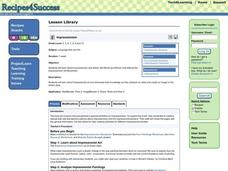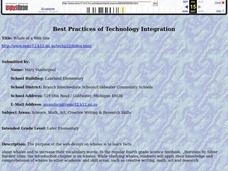Curated OER
Flying and Migration
Students listen to a read aloud of an excerpt of Janet Eaton Givens, Just Two Wings, before reviewing what birds use to fly, and the meaning of migration. They use hot lists of websites to research the Internet for information about the...
Earth Day
Introduction To Scale Drawings
Real-life math is really great! In groups, learners measure objects in the classroom. After comparing measurements, they determine a scale and create a blueprint of the classroom. They discuss the purpose of using scale drawings in...
Curated OER
Writing Letters to Legislators
Students discuss the importance of writing to their representatives. Using the internet, they identify who their representative is and ways they can communicate with them. They review the guidelines in which they need to follow in order...
Curated OER
Modernism in Poetry, Painting, and Music
Are you teaching Modernism to your class? Connect different areas of artistic expression in the Modernist Era. Learners read T.S. Eliot, view art by Pablo Picasso, and listen to a Modernist musical composition. This final assignment is...
Curated OER
Science: Fossil of a Carbonized Plant
Students classify leaves by shape and margins and use them to create models of plant fossils. By using paper over a leaf, they simulate fossilization of organisms onto sedimentary rocks. Following instructions on worksheets, students...
Curated OER
Ocean Animals
Very young learners identify ocean animal pictures by their correct name and create a book of ocean animals. They read books and lean ocean animal vocabulary using the SMART Board. A well-designed lesson!
Curated OER
Insects
It's a fact: kids love bugs! With this lesson, young learners explore reading informational texts and conducting research while learning about their favorite insects. Spark learners' interest by reading a book about one kind of bug and...
Curated OER
Facial Symmetry
Learners study facial symmetry. They explore lines of symmetry, and create illustrations with multiple lines of symmetry.
Curated OER
Media Timeline
Students study websites about the media and disabilities and identify places on a timeline where the media has influenced society with disabilities. In this disabilities lesson plan, students make a large timeline out of craft paper as a...
Curated OER
The Eiffel Tower is the Symbol of Paris
Fashioned in a simple format, the subject of this presentation is the Eiffel Tower in Paris, and could be a model for future projects. Even if your class does not do a unit on famous sites in European cities, this could be used a a way...
Curated OER
Anatomy of an Element
Learners discuss matter and atoms using this resource. First, they look at a website describing atoms. Then, they learn about the periodic table and discuss how it is organized. Finally, they create a comic strip to display their...
National Constitution Center
Address America: Your Six-Word Stump Speech
Stump speeches are the focus of this exercise that combines politics and language arts. After learning about this type of speech, the class listens to Obama's 2008 presidential campaign stump speech and answers a series of questions that...
Curated OER
All About Me
Students use a digital camera to take pictures of various faces. They then sort pictures according to eye color and create a graph. Students draw pictures of themselves on the screen using specified tools and colors. They choose hair...
Curated OER
Amelia Earhart's Final Flight
In this research worksheet, students use a teacher assigned web site to answer 7 research questions. They read about Earhart's attempt to fly around the world and the theories about her disappearance.
Curated OER
Trees Are More Than Wood
In the science and art instructional activity, students think about and draw the shape of a tree. They explain if all trees look the same before accessing a web site to read about the shapes of trees. They write down three things that...
Curated OER
Harry Potter and the Spellbound Children
Help your class explore the world of Harry Potter. Learners visit selected websites to learn the background about the book series, discover details about the marketing of the books, and investigate book banning.
Curated OER
Energy Crisis: Then and Now
Using political cartoons, scholars analyze the energy crisis of the 1970s and '80s, comparing and contrasting it to current tensions with oil. Display the 6 cartoons (linked) to the class, and demonstrate analysis using the worksheet...
Curated OER
Steps to a Healthier You
Learners explore the food pyramid. In this dietary health lesson, students examine the food pyramid on the MyPyramid.gov website and discuss healthy eating strategies. There are various links to websites in this lesson.
Curated OER
A Webpage with Frontpage
Students design a school webpage. In this webpage design lesson, students use Frontpage software to build a successful, attractive, and informational Web page.
Curated OER
Impressionism
Students explore and discuss Impressionism and artists, like Monet and Renoir, who defined the Impressionism Art Movement, choose an artist to research, and create web sites based on their research.
Curated OER
The Discount is Right
Students visit various websites and calculate various prices of five items. They estimate the sale price of five items using the original price and discount rate, use percent to calculate the rate of discount and the original price, and...
Curated OER
Creating Student Advertising
High schoolers explore common advertising strategies used by the media. In this advertising lesson plan, students identify persuasive language in advertisements and construct their own persuasive ad.
Curated OER
Whale of a Web Site
Learners compare and contrast differences and likeness of whales/fish and toothed/baleen whales and discuss what they know about whales and what they would like to study about whales. They then describe the characteristics of a mammal.
Curated OER
Creating a Leaf Collection and Classroom Herbarium
Students categorize leaves they collect from trees outdoors by consulting a variety of sources. They discuss how the form of a leaf reflects its adaptation to its environment.























